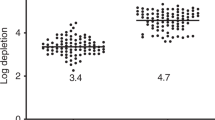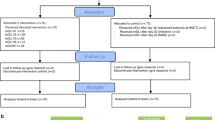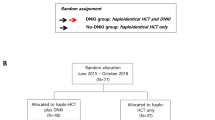Abstract
We have analyzed the clonotype composition of CD8+ T cells following nonmyeloablative (NMA) conditioning and hematopoietic cell transplantation (HCT), of patients with chronic lymphocytic leukemia (CLL). Consecutive analyses of blood samples taken up to 2 years following HCT, demonstrated that CD8+ T-cell clonality was highly dynamic in the early phases after HCT, but became more stable after 4–5 months. Moreover, donor lymphocyte infusion (DLI) given for disease progression in one of the patients led to establishment of recurrent as well as new T-cell clonotypes. This coincided with disease remission, strongly suggesting that these T cells were engaged with anti-CLL cytotoxicity. To examine the functional capacity of stable clonally expanded T cells after HCT, CD8+ T cells isolated post-transplant from the recipients were stimulated ex vivo with CLL cells and subsequently analyzed by FACS for surface expression of the marker for cytotoxic activity, CD107a. Stimulation with CLL cells indeed led to surface expression of CD107a, and clonotype analyses of sorted cells demonstrated that CD107a positive T cells were stably expanded following HCT. Our data suggest that clonally expanded CD8+ T-cell clones participate in the ongoing T-cell response against CLL cells following HCT with NMA conditioning.
This is a preview of subscription content, access via your institution
Access options
Subscribe to this journal
Receive 12 print issues and online access
$259.00 per year
only $21.58 per issue
Buy this article
- Purchase on Springer Link
- Instant access to full article PDF
Prices may be subject to local taxes which are calculated during checkout




Similar content being viewed by others
References
Michallet M, Archimbaud E, Bandini G, Rowlings PA, Deeg HJ, Gahrton G et al. HLA-identical sibling bone marrow transplantation in younger patients with chronic lymphocytic leukemia. European Group for Blood and Marrow Transplantation and the International Bone Marrow Transplant Registry. Ann Intern Med 1996; 124: 311–315.
Pavletic ZS, Arrowsmith ER, Bierman PJ, Goodman SA, Vose JM, Tarantolo SR et al. Outcome of allogeneic stem cell transplantation for B cell chronic lymphocytic leukemia. Bone Marrow Transplant 2000; 25: 717–722.
Doney KC, Chauncey T, Appelbaum FR . Allogeneic related donor hematopoietic stem cell transplantation for treatment of chronic lymphocytic leukemia. Bone Marrow Transplant 2002; 29: 817–823.
Khouri IF, Lee MS, Saliba RM, Andersson B, Anderlini P, Couriel D et al. Nonablative allogeneic stem cell transplantation for chronic lymphocytic leukemia: impact of rituximab on immunomodulation and survival. Exp Hematol 2004; 32: 28–35.
Sorror ML, Maris MB, Sandmaier BM, Storer BE, Stuart MJ, Hegenbart U et al. Hematopoietic cell transplantation after nonmyeloablative conditioning for advanced chronic lymphocytic leukemia. J Clin Oncol 2005; 23: 3819–3829.
Dreger P, Montserrat E . Autologous and allogeneic stem cell transplantation for chronic lymphocytic leukemia. Leukemia 2002; 16: 985–992.
Dreger P, Brand R, Hansz J, Milligan D, Corradini P, Finke J et al. Treatment-related mortality and graft-versus-leukemia activity after allogeneic stem cell transplantation for chronic lymphocytic leukemia using intensity-reduced conditioning. Leukemia 2003; 17: 841–848.
Dreger P, Brand R, Milligan D, Corradini P, Finke J, Lambertenghi DG et al. Reduced-intensity conditioning lowers treatment-related mortality of allogeneic stem cell transplantation for chronic lymphocytic leukemia: a population-matched analysis. Leukemia 2005; 19: 1029–1033.
Schetelig J, Thiede C, Bornhauser M, Schwerdtfeger R, Kiehl M, Beyer J et al. Evidence of a graft-versus-leukemia effect in chronic lymphocytic leukemia after reduced-intensity conditioning and allogeneic stem-cell transplantation: the Cooperative German Transplant Study Group. J Clin Oncol 2003; 21: 2747–2753.
Paneesha S, Milligan DW . Stem cell transplantation for chronic lymphocytic leukaemia. Br J Haematol 2005; 128: 145–152.
Khouri IF, Keating M, Korbling M, Przepiorka D, Anderlini P, O’Brien S et al. Transplant-lite: induction of graft-versus-malignancy using fludarabine-based nonablative chemotherapy and allogeneic blood progenitor-cell transplantation as treatment for lymphoid malignancies. J Clin Oncol 1998; 16: 2817–2824.
Esteve J, Villamor N, Colomer D, Cervantes F, Campo E, Carreras E et al. Stem cell transplantation for chronic lymphocytic leukemia: different outcome after autologous and allogeneic transplantation and correlation with minimal residual disease status. Leukemia 2001; 15: 445–451.
Rondon G, Giralt S, Huh Y, Khouri I, Andersson B, Andreeff M et al. Graft-versus-leukemia effect after allogeneic bone marrow transplantation for chronic lymphocytic leukemia. Bone Marrow Transplant 1996; 18: 669–672.
Moreno C, Villamor N, Colomer D, Esteve J, Martino R, Nomdedeu J et al. Allogeneic stem-cell transplantation may overcome the adverse prognosis of unmutated VH gene in patients with chronic lymphocytic leukemia. J Clin Oncol 2005; 23: 3433–3438.
Ritgen M, Stilgenbauer S, von Neuhoff N, Humpe A, Bruggemann M, Pott C et al. Graft-versus-leukemia activity may overcome therapeutic resistance of chronic lymphocytic leukemia with unmutated immunoglobulin variable heavy-chain gene status: implications of minimal residual disease measurement with quantitative PCR. Blood 2004; 104: 2600–2602.
Campbell JD, Cook G, Holyoake TL . Evolution of bone marrow transplantation – the original immunotherapy. Trends Immunol 2001; 22: 88–92.
Bleakley M, Riddell SR . Molecules and mechanisms of the graft-versus-leukaemia effect. Nat Rev Cancer 2004; 4: 371–380.
Hambach L, Goulmy E . Immunotherapy of cancer through targeting of minor histocompatibility antigens. Curr Opin Immunol 2005; 17: 202–210.
Tseng LH, Lin MT, Hansen JA, Gooley T, Pei J, Smith AG et al. Correlation between disparity for the minor histocompatibility antigen HA-1 and the development of acute graft-versus-host disease after allogeneic marrow transplantation. Blood 1999; 94: 2911–2914.
Goulmy E, Schipper R, Pool J, Blokland E, Falkenburg JH, Vossen J et al. Mismatches of minor histocompatibility antigens between HLA-identical donors and recipients and the development of graft-versus-host disease after bone marrow transplantation. N Engl J Med 1996; 334: 281–285.
Dighiero G . Unsolved issues in CLL biology and management. Leukemia 2003; 17: 2385–2391.
thor Straten P, Schrama D, Andersen MH, Becker JC . T cell clonotypes in cancer. Translat Med 2004; 2: 1–11.
Masuko K, Kato S, Hagihara M, Tsuchida F, Takemoto Y, Izawa K et al. Stable clonal expansion of T cells induced by bone marrow transplantation. Blood 1996; 87: 789–799.
Verfuerth S, Peggs KS, Vyas P, Barnett L, O’Reilly RJ, Mackinnon S . Longitudinal monitoring of immune reconstitution by CDR3 size spectratyping after T-cell-depleted allogeneic bone marrow transplant and the effect of donor lymphocyte infusions on T-cell repertoire. Blood 2000; 95: 3990–3995.
Porter DL, June CH . T-cell reconstitution and expansion after hematopoietic stem cell transplantation: ‘T’ it up!. Bone Marrow Transplant 2005; 35: 935–942.
Petersen SL, Madsen HO, Ryder LP, Svejgaard A, Jakobsen BK, Sengelov H et al. Haematopoietic stem cell transplantation with non-myeloablative conditioning in the outpatient setting: results, complications and admission requirements in a single institution. Br J Haematol 2004; 125: 225–231.
Sullivan KM . Graft-versus-host disease. In: Blume KG, Forman S, Appelbaum FR (eds). Thomas’ Hematopoetic Cell Transplantation. Blackwell Publishing: Oxford, 2004, 635–664.
Petersen SL, Sidorov IA, Russell CA, Dickmeiss E, Vindelov LL . Limiting dilution analysis of interleukin-2 producing helper T-cell frequencies as a tool in allogeneic cell transplantation. Transplantation 2005; in press.
Petersen SL, Madsen HO, Ryder LP, Svejgaard A, Masmas TN, Dickmeiss E et al. Chimerism studies in HLA-identical nonmyeloablative hematopoietic stem cell transplantation point to the donor CD8(+) T-cell count on day+14 as a predictor of acute graft-versus-host disease. Biol Blood Marrow Transplant 2004; 10: 337–346.
Thiede C, Florek M, Bornhauser M, Ritter M, Mohr B, Brendel C et al. Rapid quantification of mixed chimerism using multiplex amplification of short tandem repeat markers and fluorescence detection. Bone Marrow Transplant 1999; 23: 1055–1060.
Nyvold C, Madsen HO, Ryder LP, Seyfarth J, Engel CA, Svejgaard A et al. Competitive PCR for quantification of minimal residual disease in acute lymphoblastic leukaemia. J Immunol Methods 2000; 233: 107–118.
thor Straten P, Guldberg P, Grønbæk K, Zeuthen J, Becker JC . In situ T-cell responses against melanoma comprise high numbers of locally expanded T-cell clonotypes. J Immunol 1999; 163: 443–447.
thor Straten P, Becker JC, Zeuthen J, Guldberg P . T-cell receptor clonotype mapping using denaturing gradient gel electrophoresis (DGGE): Analyses of clonal T-cell responses in melanoma. In: Nicholoff B (ed). Melanoma Methods and Protocols. Humana Press Inc.: Totowa, 2001.
Guldberg P, Güttler F . ‘Broad-range’ DGGE for single-step mutation scanning of entire genes: application to human phenylalanine hydroxylase gene. Nucleic Acids Res 1994; 22: 880–881.
Claret EJ, Alyea EP, Orsini E, Pickett CC, Collins H, Wang Y et al. Characterization of T cell repertoire in patients with graft-versus-leukemia after donor lymphocyte infusion. J Clin Invest 1997; 100: 855–866.
Tivol E, Komorowski R, Drobyski WR . Emergent autoimmunity in graft-versus-host disease. Blood 2005; 105: 4885–4891.
Saitoh H, Hirokawa M, Fujishima N, Ichikawa Y, Kawabata Y, Miura I et al. The presence and longevity of peripherally expanded donor-derived TCRalphabeta+ mature T lymphocyte clones after allogeneic bone marrow transplantation for adult myeloid leukemias. Leukemia 2003; 17: 1626–1635.
Akatsuka Y, Nishida T, Kondo E, Miyazaki M, Taji H, Iida H et al. Identification of a polymorphic gene, BCL2A1, encoding two novel hematopoietic lineage-specific minor histocompatibility antigens. J Exp Med 2003; 197: 1489–1500.
Marijt WA, Heemskerk MH, Kloosterboer FM, Goulmy E, Kester MG, van der Hoorn MA et al. Hematopoiesis-restricted minor histocompatibility antigens HA-1- or HA-2-specific T cells can induce complete remissions of relapsed leukemia. Proc Natl Acad Sci USA 2003; 100: 2742–2747.
Spierings E, Wieles B, Goulmy E . Minor histocompatibility antigens – big in tumour therapy. Trends Immunol 2004; 25: 56–60.
Jaksch M, Mattsson J . The pathophysiology of acute graft-versus-host disease. Scand J Immunol 2005; 61: 398–409.
Dickinson AM, Wang XN, Sviland L, Vyth-Dreese FA, Jackson GH, Schumacher TN et al. In situ dissection of the graft-versus-host activities of cytotoxic T cells specific for minor histocompatibility antigens. Nat Med 2002; 8: 410–414.
Introna M, Barbui AM, Golay J, Rambaldi A . Innovative cell-based therapies in onco-hematology: what are the clinical facts? Haematologica 2004; 89: 1253–1260.
Acknowledgements
Supported by the Danish Cancer Society, the Novo Nordisk Foundation, Vilhelm Petersen og Hustrus legat by recommendation by the Novo Foundation, Danish Medical Research Council, and the Danish Foundation for Cancer Research.
Author information
Authors and Affiliations
Corresponding author
Rights and permissions
About this article
Cite this article
Kollgaard, T., Petersen, S., Hadrup, S. et al. Evidence for involvement of clonally expanded CD8+ T cells in anticancer immune responses in CLL patients following nonmyeloablative conditioning and hematopoietic cell transplantation. Leukemia 19, 2273–2280 (2005). https://doi.org/10.1038/sj.leu.2403972
Received:
Accepted:
Published:
Issue Date:
DOI: https://doi.org/10.1038/sj.leu.2403972
Keywords
This article is cited by
-
The T-win® technology: immune-modulating vaccines
Seminars in Immunopathology (2019)
-
Anti-regulatory T cells
Seminars in Immunopathology (2017)
-
PD-L1-specific T cells
Cancer Immunology, Immunotherapy (2016)
-
The targeting of immunosuppressive mechanisms in hematological malignancies
Leukemia (2014)
-
Harnessing PD-L1-specific cytotoxic T cells for anti-leukemia immunotherapy to defeat mechanisms of immune escape mediated by the PD-1 pathway
Leukemia (2014)



